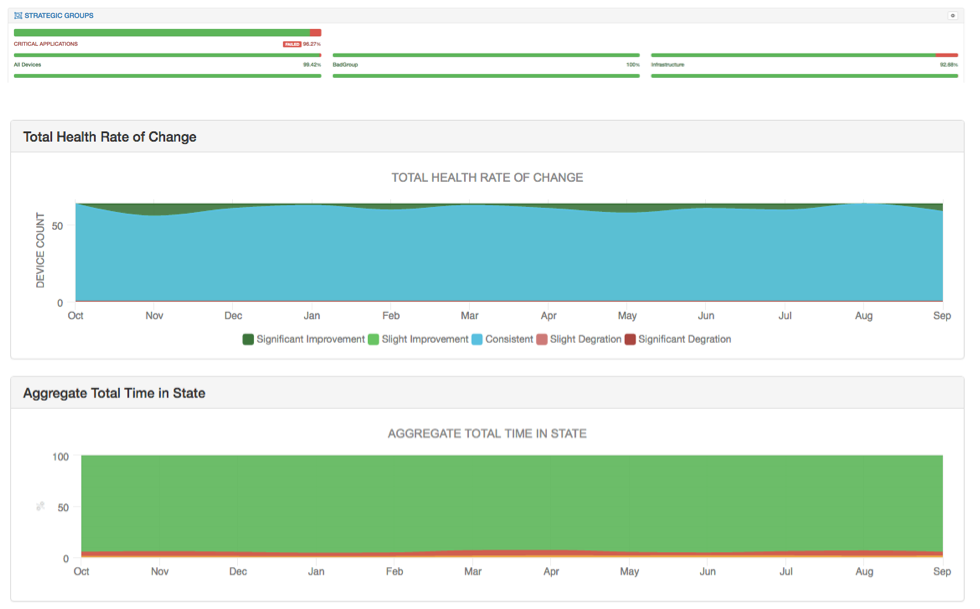
A great philosopher once said, “You can observe a lot by just watching.” Wait. What? Okay, never mind. Yogi Berra probably doesn’t reach the same rarified air occupied by Plato, Aristotle, or Socrates. After all, rhetorical gems such as “A nickel ain’t worth a dime any more” and “We made too many wrong mistakes” are also attributed to the former New York Yankees catcher. However, given the context of network and systems monitoring there is a certain amount of profundity in that initial quote if you noodle on it for a moment. Just as a photomosaic image looks like one thing when viewed from far away, but is composed of potentially thousands of smaller pictures, IT systems management is more effective when considered from a fabric-management perspective rather than one that is element-based. In other words, instead of concentrating on individual devices that may be UP or DOWN and individual disk thresholds that may or may not be exceeded it makes more sense to evaluate the impact of those events on the overall system or application being monitored.
The first reason to de-prioritize an element-based approach is that it’s way too easy for IT Systems Management staff to get lost in the technical weeds, especially with large and complex infrastructures made up thousands of devices. Systems that large typically have redundancy built into them whether that means dual WAN circuits on a given router or a cluster of database servers for a given application. Therefore, if a single element in one of those items fails it is a problem, just not a catastrophic failure that requires “drop-everyhting-and-fix-it-now” action. It’s an issue that can be addressed in due time based on its relative impact to the application or system it is a part of. Not taking this approach ultimately leads to a waste of time, money, and engineering resources.
Another reason to favor a fabric-management philosophy to managing systems is the archetypal “Pointy-Haired Boss” (of Dilbert fame). And, no, in case anybody is thinking it, the goal here isn’t to impugn the abilities of all IT Leaders out there. However, let’s be honest; All IT Managers aren’t created equal. How much sense does it really make for an engineer to submit a status report on a given WAN to their boss that looks like this:

IT Systems Management teams are responsible for a lot more than simply a smoothly running network or individual servers that stay up for “five 9s”. The information displayed above is good, but how does one translate these numbers into something that a manager can use to judge how the systems and applications they’re responsible for are in good shape? To the Pointed-Haired Bosses in our lives the above might as well be written in Aramaic. To those IT managers who do run successful organizations, sans intimate knowledge of the WAN’s technical details and how it relates to application health (which is typically the antithesis of a manager’s job), they are just pointless numbers and dots on a page. Data without context is simply noise, but that is the inevitable consequence of pursuing element-centric-only monitoring strategy.
At the intersection of IT staff taking a big-picture view of applications rather than concentrating on the minutiae and the generation of reports suitable for management consumption we come to the third reason for traveling down the Yellow Brick Road that is fabric-management: Effective IT Strategic Planning. How does the typical IT organization answer questions such as “Should we stand up a new data center to service East Coast customers?” or “Should we outsource mail to Office365?”. Of course, the answer is “data” about how existing systems are performing coupled with myriad other sources of information. At least for IT’s part in such a decision conclusions are easier to draw if the organization is already thinking in those terms.
So how do we get from Point-A to Point-B and actually make the transition to a fabric-management philosophy? Different vendors solve that problem in different ways. Netreo’s OmniCenter offers customers the concept of “Strategic Groups” and then trending dashboards to give insight into specific details about those groups. All that information is then rolled up into simple dashboards that serve the dual-purpose one-click report generation and quick drill down into a specific issue from an application-centric starting point. No matter the tools this process is simply a matter of giving some thought to how all the piece-parts of your IT organization fit together what is most import in meeting the needs of the customer.


The overall IT landscape for companies is continuing its drive towards tighter integration between technology and business processes. Managing individual routers, switches, and servers in an infrastructure IS going to take a backseat to taking a more holistic approach to monitoring as time goes on. To further quote our aforementioned major leaguer, “The future ain’t what it used to be.” Now is the time to make fabric-management a priority.